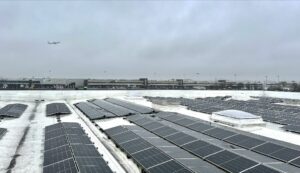Feb 20, 2024

As an airport operator, Brussels Airport aims to eliminate CO2 emissions completely by 2030. The airport is investing in more green energy, including solar energy. The newest buildings in the western section of the cargo zone are currently being fitted with a large number of solar panels, covering a total surface area of 65,000 m². Half of the solar power will be used by Brussels Airport, increasing its own energy supply through solar energy from 4% to 9%. The other half is to be used by partners in this zone.The installation work fitting the newest buildings in the cargo zone with solar panels started at the end of January. This concerns the buildings where Kuehne+Nagel, Worldwide Flight Services, Expeditors, Swissport and Herfurth are housed. Some 65,000 m² in solar panels is to be installed, accounting for a total of 7,300 megawatt hour in green power. This is equivalent to the consumption of some 2,100 households.“This new solar panel project is a major step in our ambition to achieve net zero carbon emissions. It doubles the solar energy for our own use as an airport operator and also allows us to provide locally generated green power to our cargo partners. Thereby enabling them too to further reduce their own carbon emissions.”, explains Brussels Airport Company CEO Arnaud Feist.At present, the current solar farms at the airport provide 4% of the power consumed by Brussels Airport. These additional solar panels will substantially ramp up this share to 9% of the energy supply, with Brussels Airport using just half of what these new solar panels will be generating. The other half will be available to the cargo partners, so that they too will have opportunity to use the solar energy generated at the cargo zone. Brussels Airport Company has been carbon neutral for its own emissions as an airport operator since 2018. Last year, it was decided to drastically accelerate the airport’s ambition to achieve net zero carbon, from 2050 to 2030. Solar energy is an important element in achieving this ambition and this is a first concrete realisation to achieve that goal. This first new installation should be ready by late May, so this green energy will be available come June. Other potential locations for additional solar panels are still being explored. The ambition is to achieve 27 MWp, which yields about 24,000 megawatt hours per year, by 2027.
The post Brussels Airport doubles its own solar energy with new solar panels in cargo zone appeared first on AIR CARGO WEEK.
Go to Source
Author: Edward Hardy




